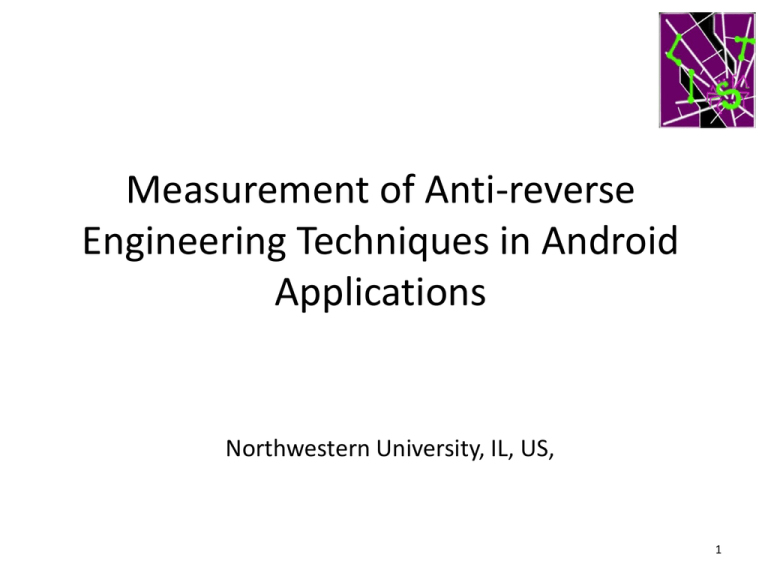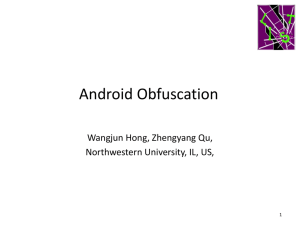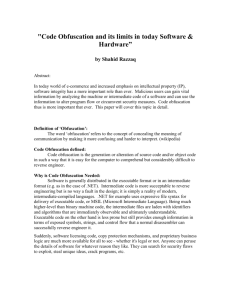MobileObfuscation - Northwestern University
advertisement

Measurement of Anti-reverse
Engineering Techniques in Android
Applications
Northwestern University, IL, US,
1
Outline
•
•
•
•
•
Introduction
Reverse Engineering Techniques
Design & Implementation
Results
Comparison
2
Android App compilation
3
Reverse engineering
Android Apps
• Reverse Engineering Talk
4
What to benefit from reverse
engineering?
• Inject ad-lib, repackage
• Steal the intelligence property
• Manipulate the execution of application
– User privacy collection, Financial loss…
• Cheat the game
5
What to benefit from reverse
engineering?
• Inject ad-lib, repackage
6
What to benefit from reverse
engineering?
• Inject ad-lib, repackage
• Steal the intelligence property
• Manipulate the execution of application
– User privacy collection, Financial loss…
• Cheat the game
7
Usage of Anti-reverse
engineering techniques
• Developers:
– Protect their private property
– Harden the security of users
• Malware authors:
– Prevent the malware from being detected and
analyzed
8
Outline
•
•
•
•
•
Introduction
Reverse Engineering Techniques
Design & Implementation
Results
Comparison
9
Lexical Obfuscation
• Package, class, method, variable, parameter
names kept in the bytecode
• Extracting lexical information helps human
understand algorithm and recover the java
code
10
Example
package artificialDriving {public class Navigator{}}
package connectionHandler {public class BluetoothHandler{}}
package userInterface {public class {}}
package a {
public class a{
public void a(){}
public void(int a){}
}
public class b{
public void a(){}
public void a(int a){}
}
}
11
Random/Non-alpha
Identifier name
public final class CcoCIcI{
private static final byte[] COcocOlo;
private static boolean CcoCIcI;
private static BluetoothAdapter IoOoOIOI;
…
}
package 你{
public class 音{
public void 你() {}
public void 你(int ){}
}
}
12
Anti-debug
• Stop execution when find debugger connected
if (android.os.Debug.isDebuggerConnected()){
android.os.Process.killProcess(android.os.Process.myPid());
}
• Stop execution when running in emulator
– Validate device identifer
– IMEI, Phone number, voice mail numer, SIM serial
number, subscriber ID, brand, device, model…
13
Tamper Detection
• Validate the size of certain files or the file
modification time stamps
• Hash values/checksums of code blocks, classes
or the whole program
• Verify the signature of the apk file
14
Anti-decompiling
• Java decompiling: dex2jar + JAD
• Damage the dex.class
• Goto not available in Java
:label_1
goto :label_3
:label_2
goto :label_4
:label_3
goto :label_2
:label_4
goto :label_2
15
Crack the apktool
• Android primary framework of APK
– Packaged with dirs: lib, res, assets
– Rename res -> R
– Change the structure of APK that could not be
captured by apktool
16
Bytecode Encryption
• Data represented only in encrypted version
within the code
• Have a paired function for the purpose
decryption
• Very diverse, hard to find a general, automatic
for detection
17
Dynamic Loading
• Dynamically load dex.class in the runtime
• Dex file stored as
– Additional file within the apk file
– Download from a remote source (not able to be
handled by static analysis)
– Within the class, using a byte array
18
Native Code
• Android Linux Kernel
• Native Development Kit (NDK), package parts
of application written by C/C++
• Invoked with Java Native Interface (JNI)
• Packaged in .so lib, hard to reverse
engineering
• Might have purposes other than just
obfuscation, such as performance
19
Reflection
• Inspection of classes, interfaces, fields, and methods at
runtime
• Modify private members at runtime
• Hard for static analysis
Crypto cryptModule = new Crypto();
privateKey = cryptModule.getPrivateKey();
Object reflectedClassInstance =
Class.forName(“de.tum.secureApp.Crypto”).newInstance();
Method methodToReflect =
reflectedClassInstance.getClass().getMethod(“getPrivateKey”);
Object invokeResult = methodToReflect.invoke(reflectedClassINstance);
20
Outline
•
•
•
•
•
Introduction
Reverse Engineering Techniques
Design & Implementation
Results
Comparison
21
Framework
22
Lexical Obfuscation Detection
• Parse the class name, super class name, field
name, method name, source name from smali
files
• Construct a dictionary by db from wikiperdia
• Check if a identifier contains meaning words
length larger than 1
23
Anti-debug Detection
• Run the application automatically on real
device and emulator
• Check if the app only crashes on emulator
24
Tamper detection
• Repackage and sign the application with our
signature
• Run the resigned version and original version
in parallel
• Check if only the resigned version crash
25
Anti decompiling detection
• Check if the application could be decompiled
to smali by using apktool
• Check if the application could be decompiled
to java by using dex2jar + jdcore
26
Other detection
• Native code
– Packaged .so file
• Dynamic Loading
– “DexClassLoader”
– “DexFile”
• Java Reflection
– Ljava/lang/reflect/Method
• Bytecode encryption
– Check if dex.class is packaged
– Check the existence of Activities in
AndroidManifest,xml
27
Results
Techniques
#Apps use (in 2400 top popularity apps
on Google Play)
Lexical Obfuscation
2398
Native Code
852
Dynamic Loading
1406
Reflection
2267
Anti-decompiling
41
Anti-debug
188
Tamper detection
300
Bytecode-encryption
5
28
Results(cont.)
Techniques
#Apps use (in 2400 top popularity apps
on Chinese App Market)
Lexical Obfuscation
N/a
Native Code
1046
Dynamic Loading
700
Reflection
1900
Anti-decompiling
30
Anti-debug
256
Tamper detection
105
Bytecode-encryption
54
29
Facts
• Social condition has great impact on Android
Obfuscation
• Technique difficulty has great impact on the
frequency of Android Obfuscation methods
30
Comparison
Techniques
Intention Ease of
use
Popularity
Ease of reverse Prevent Commerical/
engineering
injection developer
Lexical
Pure
Easy
High
Middle
No
Proguard
Native
Various
Middle
Middle
Middle
No
developer
Dynamic
Loading
Various
Middle
Middle
Middle
No
developer
Reflection
Various
Easy
High
Easy
No
developer
Anti-decom
Pure
Middle
Low
Difficult
Yes
Dexguard
Anti-debug
Pure
Easy
Low, rarely Easy
No
developer
Tamper
detection
Pure
Easy
Low, rarely Easy
Yes
developer
Bytecodeencryption
Pure
Difficult Low
Yes
Ijiami,
bangcle
Difficult
31
Thank you!
Questions?
http://list.cs.northwestern.edu/mobile/
32











